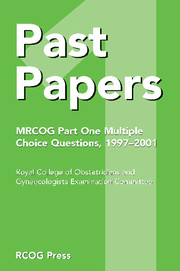Book contents
- Frontmatter
- Contents
- Introduction
- March 1997 – Paper 1
- March 1997 – Paper 2
- September 1997 – Paper 1
- September 1997 – Paper 2
- March 1998 – Paper 1
- March 1998 – Paper 2
- September 1998 – Paper 1
- September 1998 – Paper 2
- March 1999 – Paper 1
- March 1999 – Paper 2
- September 1999 – Paper 1
- September 1999 – Paper 2
- March 2000 – Paper 1
- March 2000 – Paper 2
- September 2000 – Paper 1
- September 2000 – Paper 2
- March 2001 – Paper 1
- March 2001 – Paper 2
- September 2001 – Paper 1
- September 2001 – Paper 2
- Index
September 1998 – Paper 2
Published online by Cambridge University Press: 05 July 2014
- Frontmatter
- Contents
- Introduction
- March 1997 – Paper 1
- March 1997 – Paper 2
- September 1997 – Paper 1
- September 1997 – Paper 2
- March 1998 – Paper 1
- March 1998 – Paper 2
- September 1998 – Paper 1
- September 1998 – Paper 2
- March 1999 – Paper 1
- March 1999 – Paper 2
- September 1999 – Paper 1
- September 1999 – Paper 2
- March 2000 – Paper 1
- March 2000 – Paper 2
- September 2000 – Paper 1
- September 2000 – Paper 2
- March 2001 – Paper 1
- March 2001 – Paper 2
- September 2001 – Paper 1
- September 2001 – Paper 2
- Index
Summary
1. Concerning folic acid:
A. It is a water soluble vitamin.
B. Conversion of dihydrofolate to tetrahydrofolate is inhibited by methotrexate.
C. Red cell folate concentration can be reduced by phenytoin.
D. Tetrahydrofolic acid is a carrier of one-carbon units.
E. It is involved in the synthesis of purines.
2. 2,3-diphosphoglycerate
A. is present at higher concentrations in maternal erythrocytes than fetal erythrocytes.
B. binds more avidly to haemoglobin A than to haemoglobin F.
C. increases the affinity of haemoglobin for oxygen.
D. is a phospholipid.
E. is synthesised by the pentose phosphate pathway.
3. Haematopoiesis in the fetus
A. results in nucleated erythrocytes early in development.
B. occurs in the yolk sac in the first month.
C. does not occur in the bone marrow until term.
D. is predominantly hepatic during the 4th month.
E. does not require folic acid.
4. Iron
A. is altered to the ferric state after absorption.
B. is transported by apoferritin.
C. is readily excreted by the kidney.
D. retention in the body is enhanced by chelating agents.
E. requirement during normal pregnancy is approximately 1 mg per day.
5. Cholecalciferol (vitamin D)
A. promotes the absorption of calcium from the gut.
B. is 25-hydroxylated in the liver.
C. is synthesised in the skin.
D. is 1-hydroxylated in the kidney.
E. is most active in the 1,25-dihydroxyl form.
6. Excess
A. vitamin C causes haemorrhage.
B. vitamin D causes renal failure.
C. vitamin K causes thrombosis.
D. vitamin E causes azoospermia.
E. vitamin A causes headache.
- Type
- Chapter
- Information
- Past Papers MRCOG Part One Multiple Choice Questions1997–2001, pp. 71 - 80Publisher: Cambridge University PressPrint publication year: 2004



